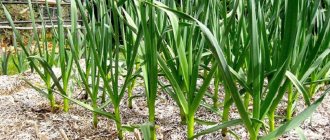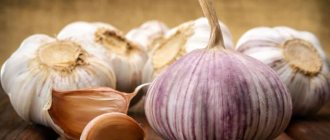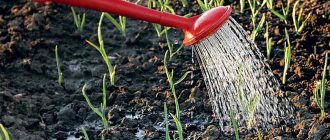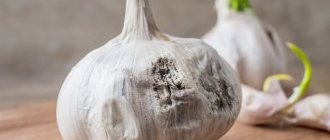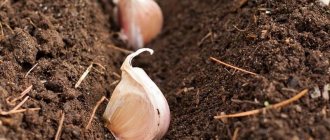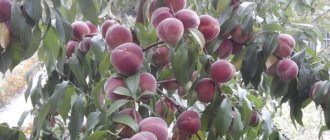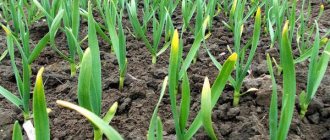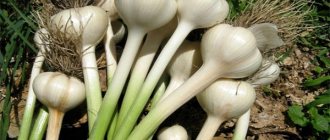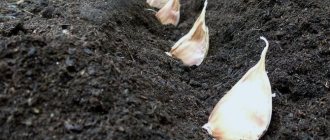The traditional method of planting garlic, which all gardeners know about, is planting with cloves. That is, you divide the head of garlic into cloves, select the best ones and plant them in October, if we are talking about winter garlic.
© DepositPhotos
Winter garlic can be planted not only as individual cloves, but also as whole heads. This method can be called lazy, since it will take you very little time to land compared to the usual method.
Features of planting garlic with a whole head
Any variety can be grown this way. From one head you can get 5-7 at once, but they will be smaller in size than with traditional cultivation. You can plant garlic around berry bushes, in beds with other plants, this way they will be protected from pests.
When planted with a head, the plant grows compact in the form of a bush. It is easier to care for and harvest once ripe. The peculiarity of this sowing method is that the spring plant yields less than the winter plant. That is, garlic planted in autumn is more prolific.
If the plot of land is small or the gardener prefers to grow small heads, then this planting option is perfect. In addition, a plant planted with a whole bulb overwinters better. For planting, you need to choose places where there is no spring melt water, otherwise the plant will quickly get wet and die.
To protect against rodents, install nets in the soil on the sides of the bulb. In cold regions, the plant is covered for the winter and removed in the spring. If you plant in the spring, you need to wait until the soil has completely thawed.
Garlic should not be planted next to onions and other bulbous plants, as they have the same diseases.
Proper preparation of the bed before planting
Winter garlic grows well in sunny areas. Therefore, the place where it is planned to be planted should be freely penetrated by the sun's rays. Light soil in which water does not stagnate is preferred. Among the key requirements for land, it is necessary to highlight its good fertile qualities and neutral acidity. It is advisable that grain, cruciferous or pumpkin crops grow on it before planting winter garlic.
An important rule: you can plant garlic in the same place only with an interval of 4–5 years. You need to wait the same time if onions and turnips previously grew in the selected area.
The soil needs to be dug up a week before planting. Rotted compost with the addition of ash can be used as fertilizer.
Advantages of planting before winter
Planting heads before winter has the following advantages:
- takes up little space, does not even require beds, planted scattered throughout the garden;
- can be planted next to plants that need protection from pests;
- the harvest is harvested in late summer, not autumn;
- when planted with heads, the plant tolerates winter frosts better;
- Garlic planted before winter gets sick less, is more persistent and strong.
In addition, there is no need to store planting material all winter, which saves space. Winter garlic is stored only until autumn; it won’t work longer - it dries out and loses its taste.
Diseases and pests: control and prevention
Garlic plantings are most often affected by fungal and viral diseases. It can be:
- penicillosis. A fungal disease affects plants during storage. It is transmitted from infected cloves to healthy ones, which become sluggish and empty from the inside, covered with a white and then green coating;
- white rot. The fungus attacks adult plants and seed material. The bushes turn yellow and dry out, a white coating similar to mycelium appears at the roots, and during storage the cloves soften and dry out from the inside;
- yellow dwarfism is a viral disease that affects the plant. The virus is transmitted by aphids. The plant stops growing, turns yellow, the feathers become lumpy, the leaves droop;
- mosaic. The feathers are covered with dots and stripes of a light yellow hue, the number of seeds decreases, the leaves become weak and bend to the ground.
The subtleties of planting garlic before winter
Winter plants should be planted two weeks before expected frost. Usually this is the end of September and the beginning of October. The garlic must have time to take root, but no green shoots, then it will overwinter in comfortable conditions.
Garlic does not tolerate a lot of organic fertilizer, so you should not overdo it with compost.
Preparing space for beds
The place for growing garlic should be sunny and without standing water. Around the end of August or beginning of September, you should begin preparing sites for planting. The soil should be light, drained, and allow water and air to pass through. The plant does not tolerate heavy and clayey soils, so you need to add sand and peat.
A bed or a separate area is dug up, loosened, and mineral fertilizers are applied. Only a little organic is needed if the soil is poor. Ash is a good source of calcium, and it also reduces soil acidity. Garlic is picky about soil composition, so sufficient amounts of fertilizer must be applied. In poor soil, the plant will develop poorly, resulting in the formation of small heads.
Then the bed should stand for some time. Garlic is planted in heads, maintaining the optimal distance between them.
Preparation for planting
Only winter varieties that are best zoned should be planted in the fall. Frost-resistant ones are suitable for cold climates, but they also feel good in the middle zone.
The most beautiful, large and even heads are chosen for planting. There should be no damage, unevenness, or rot. The top husk is removed, the bottom and top of the bulb are carefully trimmed, freeing the teeth for rapid germination.
To disinfect garlic, the heads are placed in a weak solution of potassium permanganate for 15 minutes. You can use a saline solution: put three tablespoons of salt in one bucket of water. You can use tar, which must first be mixed with a soap solution, then with water. All these manipulations are needed to destroy pests and prevent diseases.
Then the planting material should be dried by spreading it on paper or newspaper. Now he is ready to land.
Planting in open ground
Immediately before planting, the prepared soil is spilled with a solution of copper sulfate to destroy pathogens. For 10 liters of warm water you need 1 tablespoon of the drug. Per square meter of bed you will need about 2 liters of solution.
Then make a hole 10-15 cm deep and place a head of garlic there, sprout up. Cover with soil and lay mulch on top. The distance between future plants should be 25-30 cm. You can insulate the bed with sawdust, shavings, peat or spruce branches.
Snow should lie on the bed all winter; the soil should not be exposed.
Spring garlic care
As soon as the snow melts, the insulation is removed from the beds. Then sprouts will appear that will require ammonia fertilizer for normal growth. The plant can obtain nitrogen from a urea solution, which is prepared in a proportion of 15 g per bucket of water. You can also use ammonium nitrate, which is scattered around the plants in dry form.
You need to water frequently, but in moderation. Loosen and weed regularly. You can cover the soil with mulch, then the amount of watering is reduced due to the retention of moisture in the soil. Weeds grow less, so next year you get good fertilizer. When shoots appear, they are removed because they take away nutrients and the heads become weak and small.
Pros and cons of the decision to plant one-toothed trees
There are more advantages than disadvantages to planting one-toothed grass, since the seed material:
- tolerates spring frosts and severe frosts well;
- germinates quickly (the cloves do not need to be placed strictly vertically in the hole; the sprouted roots pull them down).
Note! Sprouted from sets, single-clove garlic grows large, of the same size, and retains all the characteristics characteristic of the variety.
The negative aspects of planting seedlings include:
- high cost of seeds;
- duration of the growing process.
Bulbs are obtained from the seeds, planted in the ground, sets are grown and used to produce large heads of garlic that retain varietal superiority.
What varieties can be sown this way?
All types of garlic that shoot arrows propagate by sowing. The following varieties are considered popular among vegetable growers and buyers:
- Alcor is a winter plant with a bright, pleasant aroma and a small head, weighing up to 40 g;
- Promin is a winter, early-ripening variety with a sharp taste;
- Sofievsky - has a whitish or light purple head with dark veins, weighs up to 105 g;
- Herman is a mid-season variety, the heads weigh approximately 45-50 g.
For your information! One of the best varieties for seed selection is Lyubasha. Garlic is early ripening and tolerates severe frosts and drought well. Its weight reaches 120 g. The heads are stored all winter. When sowing one-toothed grass, it is possible to reap a colossal harvest of Lyubasha. Can be grown in temperate climates and in the south.
Pest protection
Before planting, the heads must be treated to destroy existing pests. Additionally, the soil is disinfected. After harvesting, they are dried in the sun. It is important to follow planting rules and alternate places with other plants.
If the garlic is sick, you need to use formaldehyde preparations, Fitosporin and Bordeaux mixture. “Hom” and “Alirin B” give good results against fungal infections. Garlic is not susceptible to other diseases.
Will you be planting garlic heads?
Yes
No
Harvest and post-harvest work
Garlic harvesting begins after most of the leaves turn yellow. Around this time, the feathers begin to droop to the ground, and the plantings take on an unsightly appearance. The exact time depends on the region and weather conditions.
Note! In a dry year, harvesting begins already in July; if the summer is rainy, they may not clean until August.
They dig it out of the ground using a shovel. The heads must be freed from soil and left to dry in the sun. The method of drying garlic may be different. Sometimes immediately after digging the garlic:
- feathers are torn off;
- cut off the roots;
- sorted by size;
- placed in a dry and well-ventilated room, preferably in the attic.
If the garlic is left to dry in the garden, then cover it with film every evening to protect it from dew and possible rain. You need to dry it outside for 1-2 days, depending on the weather.
Garlic can be planted in two ways - cloves or bulbs, from which single cloves (sets) are grown. Garlic without cloves, the variety of which can be absolutely any, when planted, allows you to get a larger harvest, preserve varietal characteristics, and even update some of the qualities of a particular variety. Seed material is more expensive, but plantings become resistant to diseases and pests and can withstand frosts and droughts without any special consequences.
Using whole inflorescences for planting
The growing method is not suitable for everyone, as it is a troublesome task. The seedlings must be weeded, watered, and provided with regular fertilizing. When the stems dry out, the sets are immediately removed. To reduce the amount of work, gardeners sometimes use whole dried inflorescences, which are not disassembled into bulbs before planting.
To plant, you need to make a hole 5 cm deep, into which you place the dried peduncle. After this, it should be watered and covered with nutritious soil.
How deep should you place the garlic cloves?
An equally interesting question, to which there are a great many answers. If we sum them all up, we can distinguish 2 main recommendations:
- About 4 cm. This technology is quite suitable for most of the Russian Federation. But this is provided that the winter in this area is snowy. If reliable insulation of the beds is not ensured, the area is heavily blown, then garlic planted in the fall may not survive until spring - it will freeze. If not all, then a significant part of it.
- About 12 cm. Recommended for regions where the thermometer drops quite low. The advantage of this technique is that the planting material will take root well and survive the winter better. The downside is that if autumn work is carried out on heavy soil, it is much more difficult for young shoots to break through such a layer of soil. It is not a fact that they will all hatch in the spring.
Before deciding on the timing of autumn planting of garlic and the depth of placing its cloves in the ground, it is worth talking with the owners of adjacent plots who have extensive experience in growing this crop. Summer residents will be happy to share their own observations and advise on the best course of action. In this case there will definitely be no error.
What kind of garlic should be planted in the fall? Definitely not everyone. Winter planting material can be easily identified by the following characteristics:
- the number of cloves in each head is from 4 to 10 (sometimes more);
- their arrangement around the central rod is single-row;
- the shell is pinkish, with a purple tint;
- Winter garlic tastes hot.
When deciding on planting material, you need to focus on the garlic that is planted in the fall in a given region. Experiments with various hybrids and imported modifications are hardly appropriate. As practice shows, many of them simply do not survive in the ground until spring.
Differences between winter and spring garlic
Before winter, winter garlic is planted, and spring garlic is planted in spring. Beginners confuse these types, and therefore the result is not always pleasing. To avoid disappointment, study the signs of winter varieties:
- One head can have 4-12 cloves; they are large in size.
- Arrangement of teeth in a single row around a hard shaft.
- The shell is pink or purple.
Winter garlic
Spring garlic
Cloves of spring garlic can be arranged in several rows; the taste is not so spicy. The head of spring garlic does not have a stem.
Winter garlic is not suitable for winter storage, but is ideal for autumn planting.
